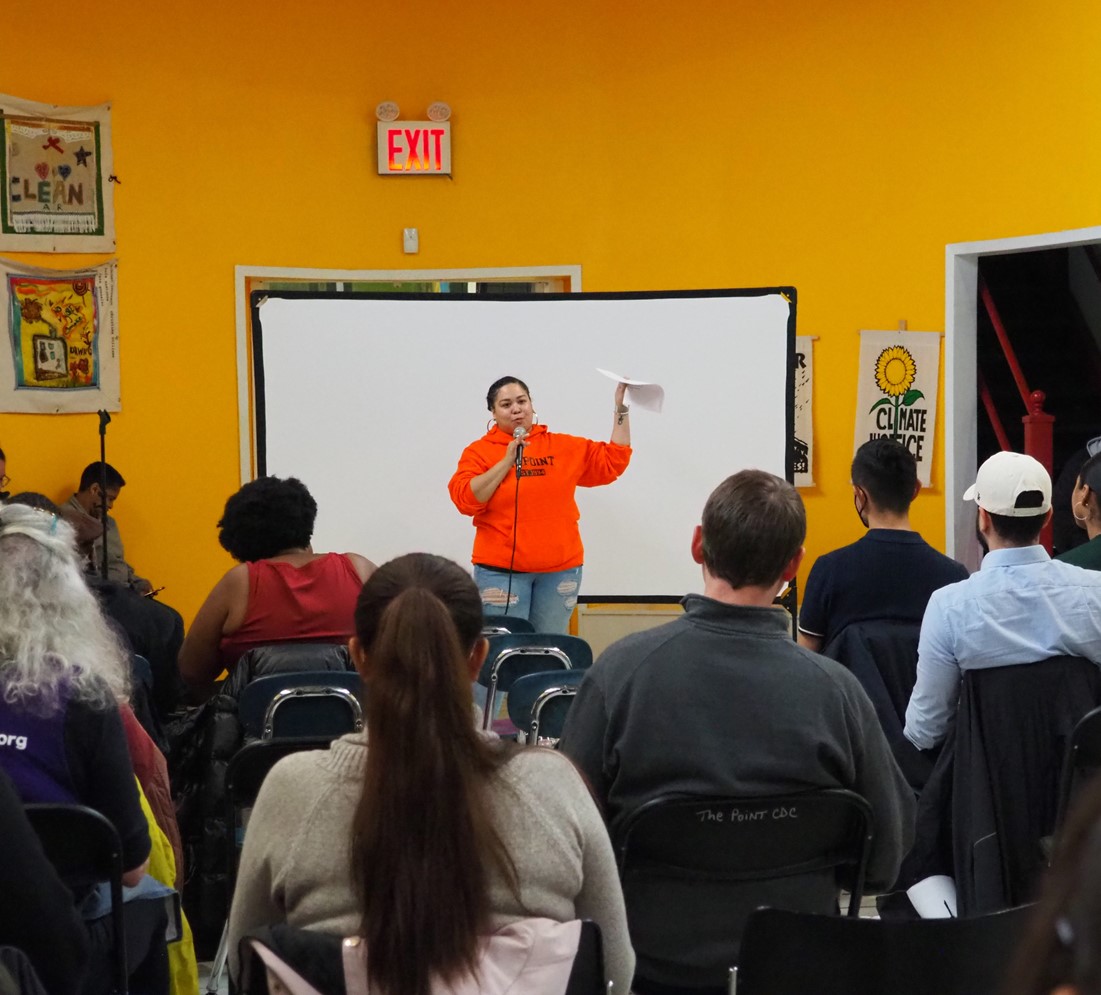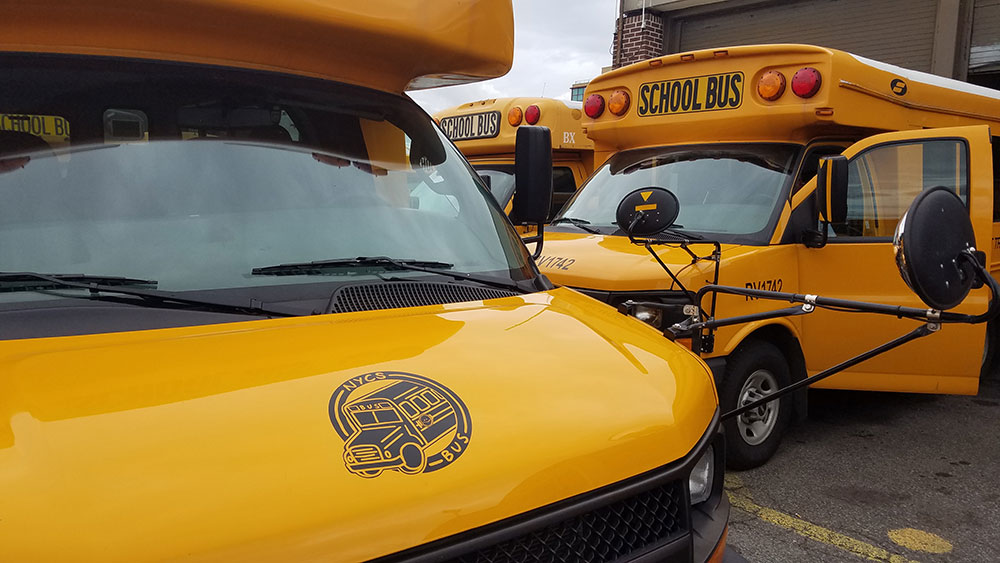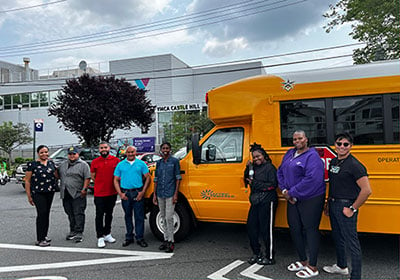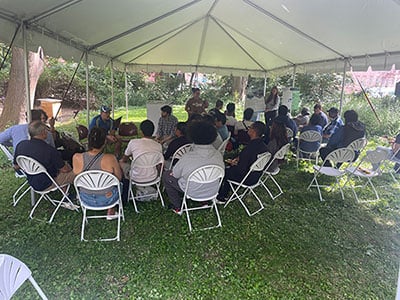New York Clean Transportation Prizes News
This is the place where you can read up on what has been happening since Grand Prize winners were announced. Find the latest news and updates below.
And, if you are interested in receiving periodic clean transportation updates from NYSERDA, please sign up for our email list!
Read about the stories and experiences of the Prize winners, and the perspectives of those community members impacted by the Prizes.
Below features articles that highlight the main goals of the New York Clean Transportation Prizes (NYCTP) program: to serve and support disadvantaged communities’ current needs, and to mitigate further disproportionate impacts caused by vehicle emissions and the resulting effects of climate change. We want to inspire others to create and implement clean transportation solutions that will benefit their communities in New York and beyond, and to provide insight into what that process may look like.
New York Clean Transportation Prizes Bulletin,
Issue #2

Today's Topic
Community Engagement Series: Running Effective Community Meetings
Achieving ambitious state-wide climate goals while meeting specific community needs can be a challenge. Focusing exclusively on high-level oversight of a project can create a disconnect between people being served, the project team, and the program managers, while hyperfocus on local issues can slow down a timeline towards large-scale change. For these reasons, NYSERDA has committed to, and continues to understand how to strengthen communication between the Agency itself, project teams and community leaders.
The Clean Transportation Prizes program’s goals are multilayered:
- Support state-wide goals for a clean transportation sector.
- Act as case studies for other communities to adopt change.
- Lower internal combustion engine (ICE) emissions and add clean transportation options to disproportionately affected communities.
How NYSERDA is working with 10 Prize teams and their communities:
NYSERDA has brought on support from community engagement experts to work with the Clean Transportation Prizes award recipients as they plan and implement their projects. These experts, ERG and their partners Hummingbird Firm and Consensus Building Institute, serve as a resource to the project teams to engage more stakeholders, improve their outreach and engagement activities in the communities where the projects are taking place. They have provided training and resources on how to develop and implement community engagement plans, how to support culturally competent outreach and act as an available resource to the prize-winning teams throughout project planning and development to assist. NYSERDA’s community engagement experts help the teams with how to capture the needs of local residents and business groups, engage more stakeholders bringing new people to the table, and address barriers to outreach. They provide ongoing review of plans and materials and are available to answer questions about challenges being faced. They also provide input to teams on design of stakeholder engagement events and community meetings. The ERG and Hummingbird Firm will continue working with teams throughout the remaining years of project implementation by having quarterly check-ins with each Prize team during their contract terms This work is an ongoing process, and as the teams learn from their communities, NYSERDA wants to see the teams incorporate what they’ve learned into their solutions.
Community Engagement in the Prizes: Q & A with experts from ERG
Q: What do you attribute to a successful working relationship between a project sponsor and community groups?
A: One of the foundational elements of a successful working relationship is taking the time to get to know each other and build trust between key people and the organizations. This includes visiting each of the teams on site, meeting with their community partners and meeting face to face with the residents and beneficiaries of the transportation solution. Meeting people where they are and understanding their constraints is a key element to building that relationship of trust.
Q: What are some ways in which one should engage community leaders and community-based organizations (CBOs) who have limited time and energy available?
A: Work around their schedule and needs, be as accommodating, flexible and inclusive as possible. Because CBOs can be “staffed” by volunteers who have day jobs, it sometimes means meeting in the evening or providing call-in numbers to meetings to make things more accessible.
Q. What insights about community engagement have emerged as you’ve worked with the grand prize-winning teams?
A: We’ve held a series of diversity, equity, and inclusion (DEI) conversations with the teams. During these conversations, team members have identified areas where they feel they hold some unconscious biases. Team members report that this understanding will help them address these biases, improve their dialogues with their communities, and move forward with more effective community engagement.
Q: Do you have any specific examples of positive community engagement that you’ve seen from the Prizes so far?
A: Seeing how the prize teams meet the community where they are, for example, Volvo’s team participating in an existing community event. (For more information on this project, keep reading!)
Volvo Technology of America, LLC: The Bronx is Breathing
The nexus of over 15,000 truck trips each workday, the Hunts Point peninsula in the South Bronx is home to the nation’s largest wholesale food hub. It’s also the location of a residential community of nearly 13,000, whose children (ages 5 to 17) were hospitalized for asthma in 2018 at nearly 2.5 times the New York City average rate.
The challenges named above correspond to the following three solutions proposed in this project:
- the repurposing of an industrial brownfield into a Recharge Hub, a publicly accessible freight-focused electric charging hub,
- a new business strategy for engaging drivers via cooperative ownership of electric trucks, and
- an emerging technical solution of battery-electric refrigeration for zero-emission trucks.
These solutions seek to decrease emissions in the adjacent neighborhoods by replacing polluting diesel and gasoline trucks by lowering financial and technical barriers to adoption and broaden access to freight electric vehicles.
In aggregate, these solutions will model a new paradigm for infrastructure deployment. The local community surrounding Hunts Point will benefit from job opportunities at the Recharge Hub and improved environmental conditions.
The idea of electric trucks at Hunt's Point's wasn't a new one. Electric trucks were originally proposed at the Point in 2000, but the technology wasn't available, so the plan was shelved. In 2016, electric trucks began showing up in Hunt's Point and the idea of a charging hub began to take root, and finally became feasible when Volvo formed a team, submitted a proposal to the Prize program and was selected as an awardee. Community voices have played a key role throughout the project proposal phase and will continue to be influential throughout the development and deployment of the project. Volvo has continued to uphold community voices and take advantage of Prize program expertise in the first year of activity. Community involvement for this project has meant understanding what the community wants to get out of the project throughout the various stages of site development, identification of cooperative ownership opportunities, plans for workforce trainings, and the development of a steering committee with key leaders to hold the project accountable to the community's goals throughout deployment.
Hosting a community meeting
In April 2023, The Bronx is Breathing team held their first community meeting after receiving their Grand Prize award. The meeting was held during an annual standing event at The Point Community Development Corporation (The Point CDC), bringing in 100+ diverse attendees, including graduate students, truck drivers, grassroots activists, local journalists, local residents and Con Edison representatives. The event was advertised by The Point CDC on their website, but the team attributes the event's great turnout to The Point CDC's long-standing prevalence and advocacy work in the community. The meeting included various activities and resources to help involve the attendees in conversation about the project. Activities included breakout group sessions, a project flyer with the project's three-pronged solution, and themed informational tables (environmental justice, the charging hub, co-op ownership models). These conversations allowed the team to gain insight into how the community members and stakeholders want to be involved as well as to update the community about the status of the project.
Some of the key takeaways from the meeting according to members of the Volvo team included gaining information on the community's goals for the project and how they want to be involved. They learned that community members really care about accountability to the promises to make Hunt's Point clean and safe. Folks expressed that they want to make sure economic opportunities from this project are invested back into the community. They are also interested in workforce development opportunities, commercial driver's license (CDL) trainings and EV truck maintenance trainings.
Community Meetings: Volvo’s "Tips for Success"
The following tips were shared by the Volvo team:
- Know your “why”?
- What do you want to know from the community?
- How can the community shape your project outcomes?
- How are you empowering the community?
- Proactively engage the community early and often.
- Follow up after the event and provide “next steps” for the community.
- Ensure accessibility:
- Translate materials and provide live interpretation when possible
- Provide free food and childcare for attendees.
- Host virtual and in person events, vary the time of day for more opportunity for people to attend
- Share the spotlight
- Share the Spotlight
- Co-locate your event at an existing community activity already popular with targeted groups and trusted by the community. Latching on to an existing event can be a fantastic way to share information about your project to a gathering of people, even if you are not the main event!
For more information on this project and other community-based mobility projects, watch the webinar from the Joint Office of Energy and Transportation: Centering Equity in Community-Based E-Mobility Projects: An Expert Panel ![]()
See also: The U.S. Department of Energy webinar on Community Benefits Agreements: Community Benefits Plans Webinar Series: CBP 101 Webinar ![]()
See Previous Bulletins
New York Clean Transportation Prizes Bulletin, Issue #1
New York Clean Transportation Prizes Bulletin, Issue #1

Today’s Topic
Zero Emissions Buses
Internal combustion engine (ICE) school buses make up the majority of the bus fleets in New York State and present a huge opportunity for reducing emissions by converting those fleets to zero-emission technologies. Similarly, buses run by transit authorities provide the same opportunity. Two of the NY Clean Transportation Prizes focus on this challenge: one led by New York City School Bus Umbrella Services (NYCSBUS) and one led by Krueger Transit Consulting in partnership with the Metropolitan Transit Authority of New York City. Keep reading for more on the current state of the transition, and information about available resources and near term activities of these two zero-emission bus Prize projects.
Electric School Buses (ESBs)
New York State is committed to purchasing all new zero emission school buses by 2027, with every school district's fleet set to transition to all-electric by 2035. Resources are being made available to school districts to help with this critical transition. Read more information about grants and funding opportunities for ESBs.
Check out the World Resources Institute Electric School Bus Initiatives’ Electric School Bus Market Study & Buyer’s Guide ![]() for details on ESB models on the market.
for details on ESB models on the market.
FAQs: See Electric School Bus Initiatives FAQ page ![]() for more information on the safety, reliability, and benefits of ESBs.
for more information on the safety, reliability, and benefits of ESBs.
Hydrogen Fuel-Cell Electric Buses (FCEBs)
Hydrogen fuel-cell electric buses (FCEBs) are a type of Zero Emissions Vehicle (ZEV) that use hydrogen as fuel. Clean hydrogen is produced via electrolysis using renewable energy. Although clean hydrogen technology is not yet well established in New York State, NYSERDA is helping to stimulate and grow clean hydrogen solutions by making up to $10 million in co-funding available for New York-based clean hydrogen research, development, and demonstration (RD&D) projects for which federal funding is also being sought and actively applied for. In addition, a $27 million hydrogen innovation budget was approved in January 2023 as part of the Clean Energy Fund (CEF). Click here for more detailed information on NYSERDA’s involvement with hydrogen development and research.
FAQs:
*All answers below are sourced from the National Renewable Energy Laboratory. Fuel Cell Electric Buses in U.S. Transit Fleets: Current Status 2020.
- How reliable are Fuel Cell Electric Buses (FCEBs)?
- On average, FCEBs are on the road for at least 20,000 miles before a major part requires replacement.
- FCEBs can be in service for an average of around 14 hours per day, but they can likely be in service for longer.
- You can count on FCEBs to be available more than 75% of the time. If buses need to be taken out of service, the most common cause is issues with the fuel system.
- How long can the Fuel Cell Electric Buses run before refueling?
- FCEBs regularly travel 150–200 miles between fueling events, however FCEBs can range about 300 miles.
- How long does it take to fuel Fuel Cell Electric Buses?
- The time to fuel each bus is about 10 minutes, but the type of fueling system chosen (e.g., mobile or permanent, liquid or gas) can either shorten or lengthen that time.
For more information on hydrogen, fuel cells and FCEBs, see NREL’s Hydrogen and Fuel Cells page ![]() .
.
Project Example #1: Back to School with Electric School Buses
Electrifying School Buses in the Bronx and Beyond (ESB3), is a Clean Transportation Prizes project led by New York City School Bus Umbrella Services Inc. (NYCSBUS). NYCSBUS and its partners are looking to improve the health of the Bronx community by transitioning diesel/gasoline school buses to electric zero emission operation. The Bronx suffers disproportionately from the air and noise pollution associated with heavy vehicles. ESB3 will not only result in the deployment of 30 ESBs at the Bronx Zerega Depot, 25 of which will be deployed early during the fall of 2023, but will also assist in workforce development through workshops and trainings for bus drivers and ESB technicians. NYCSBUS and their project partners - New York League of Conservation Voters Educational Fund, World Resources Institute, CALSTART, The Mobility House, and Bronx Community College, are all dedicated to serving the Bronx community.
Community Engagement
On June 17, 2023, the New York League of Conservation Voters Education Fund (NYLCVEF) hosted an open house event for the project team to engage the community about the project. The event took place at the Castle Hill YMCA in the Bronx, right next to the Zerega Depot, where NYCSBUS will store their ESBs. NYLCVEF’s Community Organizer, Juan Torres, said that the event was a success, with 80+ attendees of all ages. Local residents were drawn to attend via flyers that were distributed a week prior to the event. The event was intended to be an informal, inviting, and educational setting where attendees could learn and ask questions about ESBs in general, or about the specifics of the program. Educational materials included a presentation, brochures in both English and Spanish, QR codes linked to a sign up for NYCLVEF’s newsletter, and an ESB parked out front by a NYCSBUS driver, for guests to tour and ask the driver questions.

"I thought the event was successful and showed the importance of making community members aware of electric school buses. I was happy to see parents with school-aged children present. Moreover, it was a nice touch to have a bus present and offer tours and rides." – Hummingbird Firm, supporting NYSERDA’s community outreach and engagement efforts in partnership with Eastern Research Group (ERG)
Parents and drivers were equally excited about the environmental and health benefits of ESBs for their children, the community and beyond. The buses will provide more spacious, quieter rides, which is a positive for many families. The main challenge with community acceptance of ESBs has been that it’s a new technology. Some also feel that ESBs have been politicized, which has caused some doubt regarding their benefits. School districts are wary of spending money on new technology due to this lack of knowledge and perception of risks. Misunderstandings around ESBs – particularly around battery safety - have been a challenge. For these reasons, community events like this one are a crucial step to identifying doubt within the community, and then building trust and a better understanding of the technology.
Project Example #2: Hydrogen Fuel Cell Electric Buses
Krueger Transit Consulting (KTC), a firm that has supported several hydrogen fuel cell deployments, is working with Metropolitan Transit Authority (MTA) to deploy hydrogen fueling infrastructure and two hydrogen fuel-cell buses which will operate on routes out of Gun Hill Depot in the North Bronx, serving residents in areas designated by New York State as disadvantaged communities. So far, the community interaction with the project has been positive and successful, and the project has been well received. Much of their success with the community can be attributed to KTC finding and aligning with local and grassroots organizations including RAP4Bronx and the James Baldwin Outdoor Learning Center. These organizations are closely tied to the community through their food justice work, providing food and other resources to 45 community organizations in the Bronx.
The greatest benefit of this project to the community is getting about 16,000 gallons of diesel off the road per year, as FCEBs are a transit technology that emits water as its only byproduct. Another benefit will be getting away from noise pollution caused by the operation of medium- and heavy-duty transportation in the Bronx; FCEBs create a quiet, vibration-free ride for passengers. The team is looking forward to the opening day when the community will come together for the launch of the two FCEBs and MTA will provide ride-a-longs on the new buses.
Community Engagement

Krueger hosted a community event held at the Valentine-Varian House in the Bronx to educate residents on the zero-emission hydrogen powered buses that will be coming to their community. The team brought in clean vegan food and juices to share with the attendees as they engaged with clean transportation experts and project managers. The purpose of the event was to give the community some insight into the scope and timeline of the project, and to introduce them to the team. The project team noted that the demographic of the attendees were mostly younger Bronx students that came from several colleges and technical high schools. The team was impressed with the students’ knowledge about climate change, air pollution, and hydrogen electrolysis, and were excited to see the next generation interested and invested in clean transportation projects.

